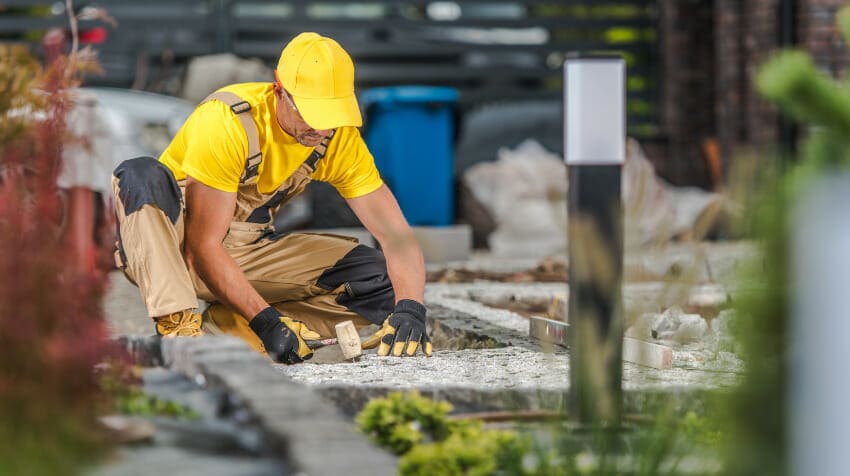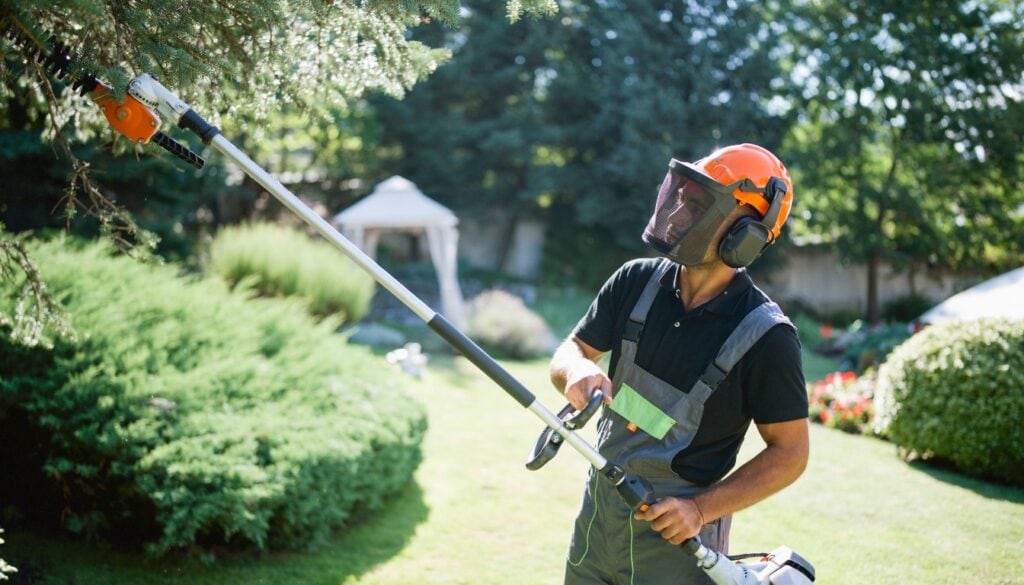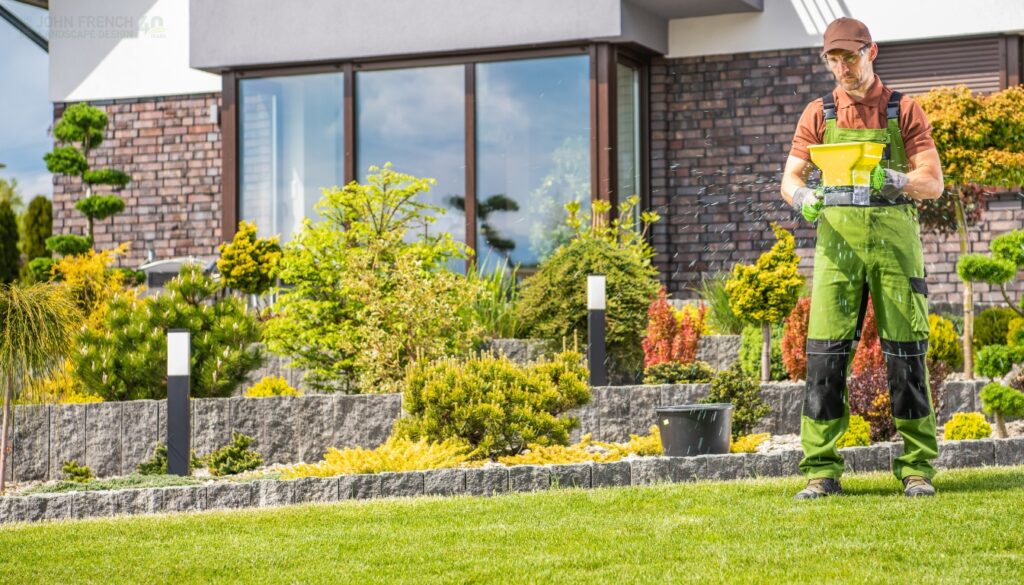Unleash the Magic: Discover the Beauty and Functionality of Hardscaping Pathways in Your Landscape
Have you ever walked through a beautifully designed landscape and felt a sense of wonder and awe? The magic of hardscaping is not just in the materials used, but in the way they are arranged to create delightful pathways that enhance the natural beauty of your surroundings.
Whether you’re looking to add value to your property or simply create a space for relaxation and entertainment, designing a stunning hardscape can transform any outdoor area into an oasis.
In this article, we’ll explore the basics of hardscaping and guide you through choosing the right materials for your project. We’ll show you how to create pathways that not only lead from one area to another but also evoke feelings of joy and enchantment.
From incorporating natural elements like water features and plants, to maintaining your hardscaping elements over time, this guide will equip you with all the knowledge needed to unlock the magic of hardscaping in your landscape.
So let’s dive in!
Understanding the Basics of Hardscaping
It’s important to grasp the fundamental concepts of hardscaping in order to create a cohesive and visually appealing outdoor space. Design principles play a vital role in achieving this goal.
By understanding symmetry, balance, contrast, and scale, you can lay out your hardscape elements in a way that flows seamlessly with your landscape. These principles can be applied to everything from creating paths and patios to incorporating retaining walls and water features.
While hiring a professional may be an option for some, there are also many DIY options when it comes to hardscaping. With the right tools and materials, you can tackle projects such as building a fire pit or constructing a garden wall on your own.
However, it’s crucial to thoroughly research and plan before starting any project. This includes taking measurements, selecting appropriate materials for your climate and budget, and ensuring proper drainage is accounted for. Understanding these basics will set you up for success when choosing the right materials for your project.
Choosing the Right Materials
When it comes to choosing the right hardscaping materials for your landscape, you need to consider several factors. First and foremost, you want to match the materials with the surrounding environment.
This means taking into account the natural elements, such as trees, water features, and rocks. Other important things to consider include durability, maintenance requirements, and cost.
Some popular hardscaping materials include concrete pavers, natural stone, brick, and wood. Each material has its own unique pros and cons that you should be aware of before making a final decision.
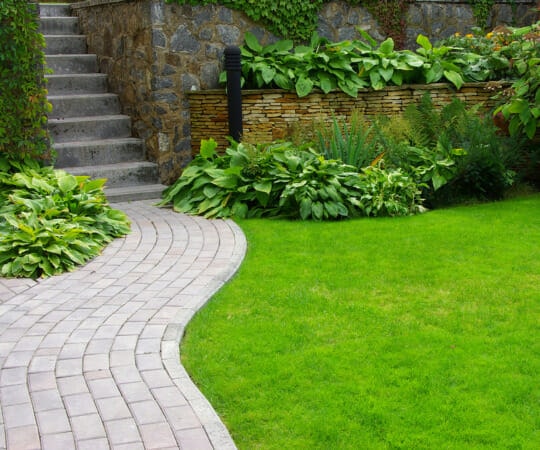
Matching materials to the surrounding environment
You’ll want to make sure the materials you choose blend seamlessly with your surroundings, so your walkway doesn’t stick out like a sore thumb and ruin the vibe.
One way to do this is by harmonizing colors. If your landscape features earthy tones, consider using materials that complement this color palette such as natural stone or brick in shades of brown or gray. On the other hand, if you have a more vibrant garden filled with colorful flowers and plants, opt for hardscaping materials in brighter hues such as reds or blues.
Blending textures is another key factor in choosing hardscaping materials that will match the surrounding environment. If you have a lush, green lawn nearby, consider adding texture to your pathway by using pavers with rough surfaces or incorporating pebbles into the design. Alternatively, if you have a rocky terrain nearby, smooth-surfaced pavers may be more appropriate.
Keep these factors in mind when selecting materials for your walkway to ensure it blends seamlessly into its surroundings without detracting from their natural beauty.
Now let’s delve into some factors to consider when selecting hardscaping materials that go beyond just aesthetics.
Factors to consider when selecting hardscaping materials
Choosing the right hardscaping materials will enhance the natural beauty of your surroundings and evoke a sense of harmony and balance. However, there are several factors to consider when making your selection.
One of these is determining whether you prioritize durability or aesthetics. While it’s important to choose materials that complement the natural environment, you also want to ensure they can withstand weather conditions and foot traffic over time.
Another factor to keep in mind is balancing your budget with quality. It’s tempting to opt for cheaper options, but investing in higher-quality materials may save you money in the long run by reducing maintenance costs and increasing lifespan. Consider the cost of installation as well – some materials require more labor than others, which can impact overall expenses.
By weighing these factors carefully, you’ll be able to select hardscaping materials that not only look beautiful but also stand up to wear and tear.
When it comes to popular hardscaping materials and their pros and cons, there are plenty of options available on the market today.
Popular hardscaping materials and their pros and cons
Get ready to explore some top-notch hardscaping materials that can elevate your outdoor space with their unique features and characteristics. Whether you’re looking for cost-effective options or durable materials that can withstand harsh weather conditions, there’s something here for everyone.
Here are a few popular hardscaping materials and their pros and cons:
- Concrete: This is one of the most affordable options available in the market, making it a favorite among homeowners who want to keep costs low. While concrete may not be as aesthetically pleasing as other materials like natural stone, it does offer excellent durability, making it an ideal choice for high-traffic areas like walkways and driveways.
- Flagstone: If you’re looking for something more visually appealing than concrete, flagstone might be the right choice for you. This natural stone comes in various colors and textures, offering endless design possibilities. However, its beauty comes at a price – flagstone can be quite expensive compared to other options.
- Brick: Another affordable option is brick. It’s easy to install and offers decent durability but may not last as long as some other materials like natural stone.
When selecting hardscaping materials, cost-effectiveness comparisons and durability assessments are crucial factors to consider. With so many options available in the market today, it’s essential to find the right balance between affordability and quality when creating beautiful outdoor spaces that withstand the test of time without compromising on style or functionality.
Now that you know about some popular hardscaping materials, let’s dive into how you can use them creatively when designing delightful pathways through your landscape.
Creating Delightful Pathways
Creating a pathway that winds through your garden can add depth and intrigue, encouraging visitors to explore all the hidden treasures nestled within. Designing curved pathways can make your landscape feel more natural and less rigid. It’s also essential to incorporate lighting features into your design to ensure safety during nighttime strolls.
When it comes to designing delightful pathways, details matter. Consider incorporating natural elements like stepping stones or small rocks alongside your hardscaping materials for a more organic look. By blending the two together, you’ll create a seamless transition between man-made and natural elements in your landscape design.
With some creativity and attention to detail, you can transform any outdoor space into a magical retreat that will delight visitors for years to come.
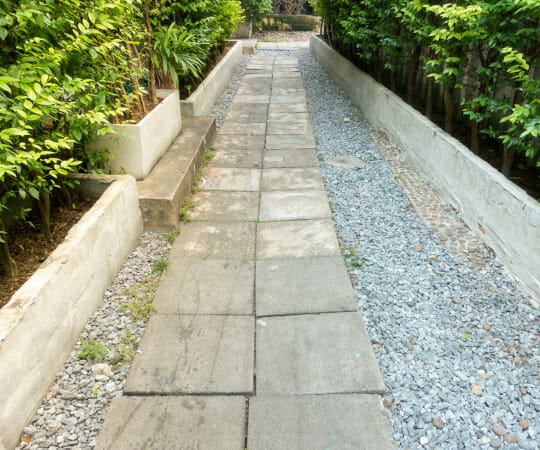
Incorporating Natural Elements in Hardscaping
Incorporating natural elements like stones and plants into your outdoor space can create a harmonious blend of man-made and organic features, adding depth and texture to the overall aesthetic. While synthetic hardscaping materials may offer durability and uniformity, natural stone pathways or retaining walls can provide a unique charm that no synthetic material can replicate.
Additionally, integrating plants such as groundcovers, shrubs, or trees into your hardscape design can enhance the beauty of your landscape while simultaneously providing functional benefits such as erosion control or shade. When selecting the right plants for your hardscaping project, consider factors such as climate suitability, growth habit, and maintenance requirements.
Groundcovers like creeping thyme or sedum can add color and texture to a pathway while also reducing weed growth. Shrubs like boxwood or juniper can be used to define borders or create focal points within a larger area. Trees like dogwood or cherry blossom not only provide shade but also add seasonal interest with their beautiful blooms.
By incorporating these natural elements into your hardscaping design, you’ll create an inviting outdoor space that is both visually appealing and functional. As you begin to enjoy your new space, it’s important to understand how best to maintain these elements to ensure their longevity and continued beauty.
Maintaining Your Hardscaping Elements
As you venture into maintaining your natural hardscaping elements, remember that nature has a way of taking its course and it’s important to strike a balance between controlling the elements and allowing them to thrive.
DIY maintenance can be an option for some homeowners who have experience with gardening or landscaping, but keep in mind that hardscaping requires special tools and techniques that may require hiring professionals.
Regular cleaning is essential in keeping hardscaping elements looking their best. Sweeping away debris like fallen leaves, dirt, and mud from walkways and patios should be done at least once a week. Pressure washing can also help remove stubborn stains on concrete surfaces.
For areas where weed growth is common, regular maintenance such as pulling out weeds by hand or using organic herbicides can prevent them from spreading and damaging the hardscaping elements.
Remember that routine inspections are key in catching any potential problems early on before they become bigger issues that require costly repairs. When in doubt, don’t hesitate to seek professional advice or services to ensure the longevity of your hardscape investment.
Frequently Asked Questions
Can hardscaping be done in areas with limited space?
Limited space doesn’t have to limit your hardscaping dreams. Vertical hardscaping is a great solution for maximizing functionality in small areas.
Think of walls, fences, and trellises as blank canvases waiting to be transformed into stunning features that serve a purpose beyond just aesthetics. By incorporating vertical elements into your design, you can create privacy screens, planters, seating areas, and even water features without sacrificing valuable square footage.
With the right planning and execution, you can turn any limited space into a beautiful and functional oasis with the magic of vertical hardscaping.
How can hardscaping be used to improve the overall aesthetic of a property?
You might think that designing a beautiful landscape involves filling it with as much greenery as possible, but what if we told you that hardscaping could actually improve the overall aesthetic of your property? Yes, you read that right.
By incorporating natural elements and designing with texture and color, hardscaping can be used to create stunning pathways and outdoor spaces that will leave your guests in awe. From stone walkways to wooden decks, the possibilities are endless.
So don’t be afraid to mix things up and think outside the box when it comes to designing your dream outdoor space!
Are there any safety concerns to consider when designing hardscaping elements?
When it comes to designing hardscaping elements, safety should always be a top priority. Choosing appropriate materials is crucial to ensuring that your pathways and other features are safe for use. For example, certain types of stone can become slippery when wet and increase the risk of slips and falls.
Proper installation is also key; if a pathway or retaining wall is not installed correctly, it could collapse or shift over time, creating a dangerous situation. By taking these factors into consideration and working with a knowledgeable professional, you can create beautiful hardscaping elements that are both aesthetically pleasing and safe for everyone to enjoy.
What are some creative ways to incorporate lighting into hardscaping design?
Imagine walking through a fairytale garden, where every step illuminates the path ahead like fireflies in the night. Lighting placement and color schemes are just two ways to explore the possibilities of hardscaping illumination.
Incorporating lighting into your design can transform any outdoor space, creating an enchanting atmosphere that’s both practical and beautiful. Whether it’s highlighting a water feature or guiding guests along a pathway, the right lighting can make all the difference.
With so many options available, from string lights to spotlights, it’s important to consider not only functionality but also aesthetics. By incorporating creative lighting techniques into your hardscape design, you can unlock a whole new world of magic in your landscape.
How can hardscaping elements be designed to accommodate changes in weather and climate?
Designing hardscaping for unpredictable weather and incorporating climate change has become a crucial aspect of landscape design. With extreme weather becoming more frequent, it’s essential to enhance the durability of hardscaping elements to withstand harsh conditions.
This can be achieved by selecting materials that are resistant to high winds, heavy rain, and extreme temperatures. It’s also important to consider the placement of hardscaping elements in relation to natural drainage patterns and potential flood zones.
By taking these factors into account during the design process, you can ensure that your hardscaping will remain functional and beautiful for years to come despite changes in weather and climate.
Conclusion
Congratulations! You now have the knowledge to design a delightful hardscaping pathway that will leave your friends and family in awe. By understanding the basics of hardscaping and choosing the right materials, you can create a beautiful path that complements your landscape perfectly.
But did you know that a well-designed outdoor space can also increase the value of your home? Homeowners who invest in landscaping projects can see an average return on investment of 109%. So not only will you enjoy the benefits of a stunning pathway, but it could also pay off in the long run.
Remember to incorporate natural elements into your hardscaping design and maintain it regularly for optimal results. With these tips and tricks, you’ll be on your way to creating a magical outdoor oasis that everyone will love.
Happy designing!
Related Sources
6 Tips To Create The Perfect Paths For Hardscaping Features In Landscaping Design

